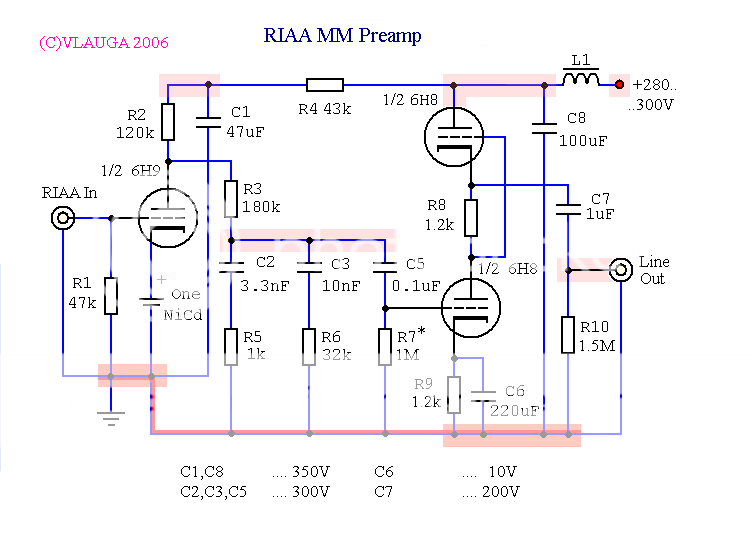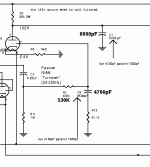You got it, except for one thing. I wouldn't reference the supply to ground, but lift it to about 50V.
Alternatively to the 12.6V supply, you can make a single 6.3V supply and simply connect the 6DJ8 in parallel.
Use 6.3 V on the 12AY7 by connecting one end to pin 9, the other end to pins 4 and 5. That way each half the AY7 filament sees 6.3V. Same heating as 12.6 across the entire filament. If you like, think of the 12AY7 filament as two 6.3V filaments in series. Steve Bench actually shows the pin connections for this.
With this approach, you can follow Salas' suggestion of using a single winding, but a separate voltage reg for each tube, if you like.
Sheldon
Alternatively to the 12.6V supply, you can make a single 6.3V supply and simply connect the 6DJ8 in parallel.
Use 6.3 V on the 12AY7 by connecting one end to pin 9, the other end to pins 4 and 5. That way each half the AY7 filament sees 6.3V. Same heating as 12.6 across the entire filament. If you like, think of the 12AY7 filament as two 6.3V filaments in series. Steve Bench actually shows the pin connections for this.
With this approach, you can follow Salas' suggestion of using a single winding, but a separate voltage reg for each tube, if you like.
Sheldon
Sheldon said:With this approach, you can follow Salas' suggestion of using a single winding, but a separate voltage reg for each tube, if you like.
Sheldon
Just one thing to remind. Having a 16V secondary, as Kofi ordered, will burn more power across the 317(s) if 6.3V will be used. A bigger heat sink is advisable.
Kofi Annan said:I guess I meant that the heater-induced noise would be greater with increased current on the heaters. I agree that the power dissipation would be the same, though...
Kofi
You could argue either case, with respect to noise. Probably a wash. If you regulate, you can burn off a little less overall with the higher voltage, as the dropout voltage of the regulators is the same with both cases, but the current is higher with 6.3V out.
Sheldon
OK-- I need some help with the heatsinks.
It looks like only the MOSFETS will require them, but I'm looking on Mouser and I think I'm out of luck there-- they appear to all be too small (36C @ 15W to about 76C @ 6W). I'm certainly no expert at this, but if Salas' recommendation was around 2.5K/W per sink, I'm screwed.
Any thoughts on proper heatsinking for these?
Kofi
It looks like only the MOSFETS will require them, but I'm looking on Mouser and I think I'm out of luck there-- they appear to all be too small (36C @ 15W to about 76C @ 6W). I'm certainly no expert at this, but if Salas' recommendation was around 2.5K/W per sink, I'm screwed.
Any thoughts on proper heatsinking for these?
Kofi
Got it! Thanks!
So, I'm working on my parts list and I'd like some recommendations:
For resistors, I've stayed with some metal fim jobs wherever possible-- mostly Vishay Dales. Any issues with this?
Also, I'm working on the capacitors and I was going to go with silver micas for the 5700pF / 6500pF jobs (although I'd consider -styrenes as the micas get expensive in these values), poly-somethings for the other caps with the exception of the lower section of the 12AY7 bypass caps, which is looking electrolytic to me. Oh yeah-- and maybe a nice Auricap for the .15uFs on the output.
Comments?
Kofi
So, I'm working on my parts list and I'd like some recommendations:
For resistors, I've stayed with some metal fim jobs wherever possible-- mostly Vishay Dales. Any issues with this?
Also, I'm working on the capacitors and I was going to go with silver micas for the 5700pF / 6500pF jobs (although I'd consider -styrenes as the micas get expensive in these values), poly-somethings for the other caps with the exception of the lower section of the 12AY7 bypass caps, which is looking electrolytic to me. Oh yeah-- and maybe a nice Auricap for the .15uFs on the output.
Comments?
Kofi
Kofi Annan said:I'd consider -styrenes as the micas get expensive in these values), poly-somethings for the other caps with the exception of the lower section of the 12AY7 bypass caps, which is looking electrolytic to me.
Styrenes should be fine. Might be hard to get low enough tolerance, unless you have a way to measure them accurately.
Instead of the 2.8k bypassed resistor under the AY7, I used a green low current LED. Works just dandy, and SY Approved, to boot.
Sheldon
Kofi Annan said:I'm guessing there'd be no need to bypass the LED given the constant current. Could I use a 1.7V greenie like in Salas' regulator?
Yes, as in yes, no need to bypass the LED. Some use a small film cap for possible HF noise, but I can't hear any difference. If you look at my link, I fed a little extra current to the LED, but that's may be overkill here, given that resistor above. On the other hand, it's easy to do.
And, yes.
Sheldon
Something like this should be fine, even at low current:
http://mouser.com/Search/ProductDetail.aspx?qs=4kLU8WoGk0ufLkQmM3v%2bcg==
Sheldon
edit: wrong part first time
http://mouser.com/Search/ProductDetail.aspx?qs=4kLU8WoGk0ufLkQmM3v%2bcg==
Sheldon
edit: wrong part first time
Dear Mr. Kofi Annan!
I developed this RIAApreamp specifically for beginners RIAApreampDIYer.
For the last three years this design was repeated by many people.
Including absolute humanists and humanities.
In respect of quality of sounding this design has only positive responses.
It is the scheme:

The first tube is any best sounding clone 6SL7, the second tube is 6SN7 (also any best sounding).
Here is possible to read detailed enough description for beginners how to make this design of improvised means (text language - one of official United Nations languages):
http://vlauga.livejournal.com/4812.html
or
http://audioportal.su/amplifiers/p2_articleid/27
BW, VU
I developed this RIAApreamp specifically for beginners RIAApreampDIYer.
For the last three years this design was repeated by many people.
Including absolute humanists and humanities.
In respect of quality of sounding this design has only positive responses.
It is the scheme:

The first tube is any best sounding clone 6SL7, the second tube is 6SN7 (also any best sounding).
Here is possible to read detailed enough description for beginners how to make this design of improvised means (text language - one of official United Nations languages):
http://vlauga.livejournal.com/4812.html
or
http://audioportal.su/amplifiers/p2_articleid/27
BW, VU
Vlagua: Nice circuit.
Kofi: Today I had done a long tuning session on the Bench, measuring and listening against my other DIY and a very high dollar commercial phono. In case you will find the sound with original values questionable, keep in mind the values attached.
Kofi: Today I had done a long tuning session on the Bench, measuring and listening against my other DIY and a very high dollar commercial phono. In case you will find the sound with original values questionable, keep in mind the values attached.
Attachments
Vlauga,
This looks interesting, but I'll probably stick with the Bench RIAA for now as I have already ordered some parts.
Salas,
I'll order the original caps / RIAA resistor and the values you recommended as well. I can do a quick swap during listening tests to see which works better.
Thanks for all the input. I've got a parts list together, which I'll upload shortly for peer review.
Kofi
This looks interesting, but I'll probably stick with the Bench RIAA for now as I have already ordered some parts.
Salas,
I'll order the original caps / RIAA resistor and the values you recommended as well. I can do a quick swap during listening tests to see which works better.
Thanks for all the input. I've got a parts list together, which I'll upload shortly for peer review.
Kofi
Kofi,
Thanks to your posts I built the TL "El Cheaop" phono and linestage. It sounded very good (indeed the best of the handful of phono stages I built) but I have a problem with excessive hum. I'm rebuilding it in a larger case, paying attention to layout and wiring sheme.
The reason I'm writing is to encourage and ask you to post your building and listening experiences. Your posts can be very encouraging to newbies like me. Going by the favourable comments about the Steve Bench phono I am going to build one after I solve (I hope) the hum problem on my 'el cheapo' TL phono stage.
Thanks and best wishes for an happy new year to all members.
Joe A
Thanks to your posts I built the TL "El Cheaop" phono and linestage. It sounded very good (indeed the best of the handful of phono stages I built) but I have a problem with excessive hum. I'm rebuilding it in a larger case, paying attention to layout and wiring sheme.
The reason I'm writing is to encourage and ask you to post your building and listening experiences. Your posts can be very encouraging to newbies like me. Going by the favourable comments about the Steve Bench phono I am going to build one after I solve (I hope) the hum problem on my 'el cheapo' TL phono stage.
Thanks and best wishes for an happy new year to all members.
Joe A
- Status
- This old topic is closed. If you want to reopen this topic, contact a moderator using the "Report Post" button.
- Home
- Amplifiers
- Tubes / Valves
- Kofi Annan in: "Cascodin' with Steve Bench's RIAA!"
